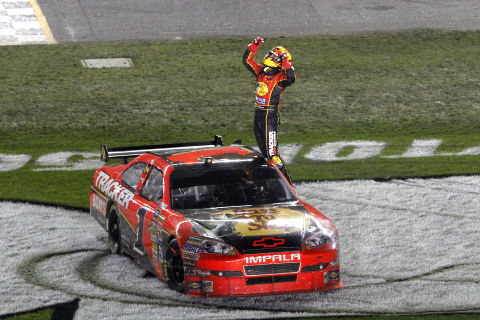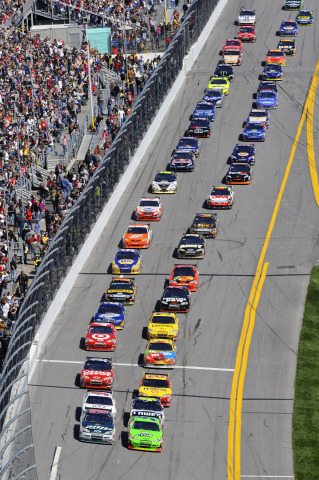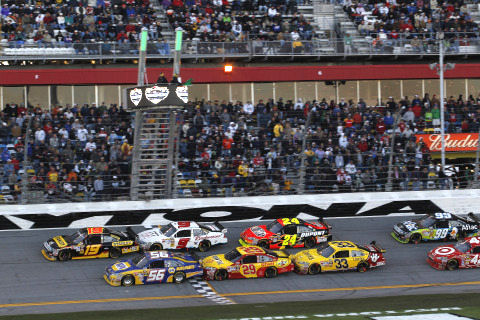The Way It Is/ NASCAR's plans for the future
by Gordon Kirby Next week I'll take a close look at the Delta Wing Indy car concept. This week I'm reporting from Daytona and looking at where NASCAR is headed technically over the next few years. While the Delta Wing represents a potential revolution for the sport, change as everyone knows, comes more glacially to NASCAR.
Next week I'll take a close look at the Delta Wing Indy car concept. This week I'm reporting from Daytona and looking at where NASCAR is headed technically over the next few years. While the Delta Wing represents a potential revolution for the sport, change as everyone knows, comes more glacially to NASCAR.
This year's 500 produced a surprise win by Jamie McMurray for Earnhardt-Ganassi Racing. It was McMurray and the team's first Daytona 500 win although the team scored a series of Daytona wins in its former iteration as Dale Earnhardt Inc. A series of late race yellows and green-white-checkers meant it took 208 laps to complete the race with the field undergoing a complete rescramble in the closing laps. In the end McMurray won from a charging Dale Earnhardt Jr. and Greg Biffle who looked a likely winner until the final restart.
The race also suffered almost three hours of delays while the track's maintenance team struggled to repair of hole in the track in turn two. Many fans left the track during the repairs and the unfortunate situation surely resulted in serious damage to the TV ratings over the race's extended second half.
In thirty-six years of covering the Daytona 500 this was by far the coldest, wettest Speedweeks I've witnessed. There were more cool, overcast days than sunny days and it rained again all day last Friday, flooding the place and delaying the Truck race and Nationwide qualifying. Amid cold weather and a tough economy crowds were down all week and the crowd on Thursday for the pair of 150-mile qualifying races was the smallest in many years, not only in the grandstands but among the motorhomes and camping area too.
Jimmie Johnson scored a superb win in he first 150-miler, beating Bud Shoot-Out winner Kevin Harvick and Kyle Busch after staying out on the final yellow when almost everyone else pitted for fresh tires. Kasey Kahne was equally impressive in winning the second qualifying race. It was Kahne's first win at Daytona and a real shot in the arm for Richard Petty Motorsports, newly-equipped this year with Ford engines and sheet metal. Kahne beat Tony Stewart, Juan Pablo Montoya and Kurt Busch.

© LAT USA
Fifty-four cars started the qualifying races. There were also fifty-seven Nationwide cars and forty-two Trucks in the garages at Daytona. Even in tough times NASCAR continues to draw plenty of teams and cars and there's no doubt that stability and slow evolution continues to and always will be NASCAR's mantra.
Some detail changes are coming however, starting with a move to fuel injection no earlier than 2011. A subsequent move to a biofuel is expected a few years later. A Bosch fuel injection system was tested recently by Hendrick and by all accounts the test went flawlessly. I talked last weekend to NASCAR's vice president of competition Robin Pemberton about the coming move to fuel injection and other changes NASCAR is likely to implement over the next three or four years.
"We're working on fuel injection and the testing has been fine," Pemberton said. "We're not there yet because what we have to do from the regulation side is make sure everybody's got the same opportunity. The architecture is so different with each of our four different manufacturers and we have to let them work through all the details to give everybody an even chance. We have to make sure we're not handcuffing anybody so that they're short on power or performance.
"If it was one guy or one team, it would be easy to build a system. But the difficult part is getting to where everybody's comfortable with how it fits into their architecture and how we regulate it, and that's going to take a little time. We won't make the change before 2011."
A few years further down the road NASCAR expects to switch to a bio-fuel of some type, most probably E10 or E85.
"We're in the discussion stages with various people about fuel," Pemberton says. "We're just trying to keep abreast with what's being done with fuel and what potentially is out there in the future, whether it's near or far. We're just trying to keep a handle on it and see where everything's going.

© LAT USA
NASCAR's new Nationwide car will run four races this year--Daytona in July, Michigan in August, Richmond in September and Charlotte in October--before being adopted full time in 2011.
"That gives the teams four reasonably different racetracks to run and get data and get tuned up and work on building and maintaining the cars and inspecting those things," Pemberton said. "It's up to the manufacturers what platforms they want to promote and Dodge was really happy to go with the Challenger and Ford with the Mustang. They felt like the Nationwide series was the right place for those cars. They have a very unique look and that's something we're really embracing in the Nationwide series."
Some refinements will be made to the Sprint Cup car over the next few years but Pemberton stressed that no major changes will be made.
"The Cup side will be a different platform for the manufacturers to promote," he noted. "We're due for a facelift in the Cup series soon. Probably there will be some small things next year and some bigger changes a year or two later. Again, it's up to the manufacturers to tell us that they're ready to have a new style and new look. We work with them. That's why we are where we are today because of everybody working together, not with any one person or group making a choice.
"Chevy has told us more than once that they're not interested in bringing the Camaro to the Nationwide or Cup series. That's totally their option. We would surely like them to, but that's not what they want to do. They're happy with the Impala brand and Toyota's happy with the Camry.
"When we make any changes it doesn't necessarily mean the nameplate will change. If we do a complete redesign of the body in the Cup series it doesn't mean that it won't continue to be an Impala or Camry. Lord knows where Ford will be, whether it's a Taurus or a Fusion. And who knows what the Dodge guys have coming to the market down the road?
"But again, there will be some small changes next year. Then maybe two years from now there may be some bigger changes. "
Pemberton added that this year's upcoming change back to a spoiler from a wing will keep the teams and NASCAR fully occupied.

© LAT USA
"We've done plenty of testing since mid-December comparing the wing and spoiler. Our guys, Dana Honeycutt and Mike Fisher and the whole R&D group have been working with the teams and manufacturers. They've been in full-scale rolling road tunnels, scale model tunnels and static, Lockheed-style tunnels. We've done this not just with our wind tunnel car but with current race cars that are being raced today and next week and next month.
"So when we settle on the spoiler we'll be as close as you can be. We're really happy with the balance we're seeing. It makes a little more downforce than with the wings and I think most of the drivers will be happy with it."
Mounted as it is close to the deck NASCAR's wing is much more a spoiler than a wing. To work effectively as an airfoil it needs to be mounted much higher in cleaner air but Pemberton says neither NASCAR's fans nor the teams showed much enthusiasm for wings.
"The wing wasn't embraced by the majority of our fan base," he remarked. "It served a purpose. I think there were some things that we tried to do using the wings to help the cars be more adjustable. With the wing you can have different end plates and there are a lot of different things you we can do around that. But if it's not what the vast majority of our fan base wants and we can get to the balance that the teams want to work with in a different way that makes the teams and the fans happy.
"The wing is a good tool but not everybody embraced it. Quite frankly, I think there are teams that don't really have a handle on the adjustments needed and there are some that don't care. A large majority of the Cup garage just want us to tell them what the rules are and may the best man win. We used the wing to try to attract maybe a younger audience and maybe that didn't work. But we're not tied to any of this stuff forever."
As usual the Daytona 500 provided little or no revelations about who will contend for this year's Sprint Cup championship. The season-opening restrictor plate race is a unique event and it will take many more races before the real form of 2010 takes shape. Meanwhile, despite its many troubles, NASCAR continues to ride a million miles ahead of any other form of American motor racing.
Auto Racing ~ Gordon Kirby
Copyright 2010 ~ All Rights Reserved
Copyright 2010 ~ All Rights Reserved
Top of Page